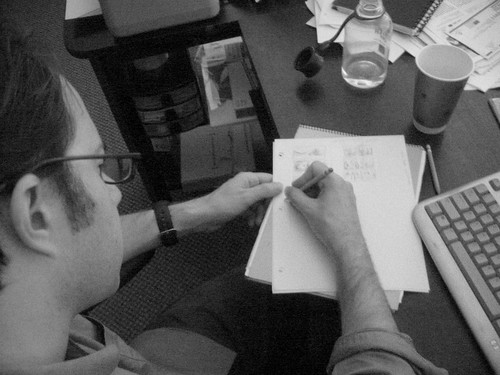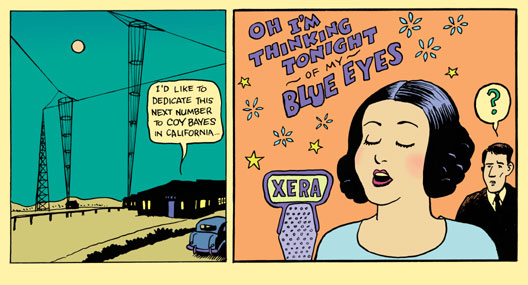Many people who know the work of my collaborator, David Lasky, may not recognize my name. It doesn't help that I have a rather common monicker. There are a lot of Frank Youngs in this world.
This particular Frank Young is proud to be the co-creator of this graphic novel. I have been an admirer of the Carter Family's music since the year 1984.
Along the way, I've been the editor of
The Comics Journal, had hundreds of articles published in newspapers, magazines and literary journals; I've edited for newspapers and magazines as well.
More recently, I wrote several installments of Justin Green's late, lamented "Musical Legends" strip, from the equally moribund
Pulse! magazine. (They're collected in the Last Gasp trade paperback that gathers Green's first-rate work on the strip.)
I have also been a writer and editor for Dana Countryman's
Cool 'n' Strange Music! magazine (where I interviewed guitar wiz Les Paul), and I've sold gags to Topps Chewing Gum's iconic "Wacky Packages" trading cards.
As well, I've written several kids' non-fiction books, been in an instrumental band called the New Albanian Riots (check out our MySpace page!), and written a couple of yet-unpublished novels and some yet-unproduced screenplays.
Like David, I live in Seattle, Washington. I moved here to work for Fantagraphics in July, 1991. I must like it here; I haven't moved since.
Back in '84, I lived in Tallahassee, Florida. I wrote full-time for a long-gone "alternative" weekday paper called
The Florida Flambeau. That paper was my training ground as a writer. I probably got most of the bad writing out of my system in the 11 years I worked for the "Flam." I was 17 when I first wrote for the paper, in 1980.
In 1984, my friend Michael Ogden first brought the Carter Family's music to my attention. I was on the verge of a discovery of country music, from the 1920s to the mid-1960s. Prior listening obsessions--Bob Dylan and Woody Guthrie, in my high-school years--had prepared my ears to travel a bit further back in time.
Mike Ogden had a cassette of a German RCA International collection of Carter Family music. Imaginatively titled
20 of the Best (Catalog #:NL 89369), this album, in cassette form, made a huge impression on me.
The "Bristol Sessions" recordings were avoided. Otherwise, this LP hit the high spots of the Carters' 1928-1934 Victor recordings. Injudicious "room tone" fake reverb had been added to the original recordings. Otherwise, they had no overdubs; nor were they abhorrently remixed in fake "stereo" (the fluorescent light of recorded sound).
This music, at first, struck me as even rougher than Bob Dylan's first recordings. (Dylan's 1961 debut disc was my prior standard-bearer of rustic-type music.) It was something of a shock at first. I couldn't believe that a recording as raw and rural as "Little Darling Pal Of Mine" could have ever existed. (I had, obviously, not yet heard the music of Charlie Patton.)
The songs hooked me first. "John Hardy Was A Desperate Little Man" reminded me of Woody Guthrie's "Tom Joad" (for obvious reasons; Guthrie helped himself to "Hardy"'s melody for his Steinbeck-influenced epic). "Lonesome Pine Special," "I Never Will Marry," "Lonesome Valley," "The Church in the Wildwood," "Lulu Walls," "Kitty Waltz," "Jimmy Brown the Newsboy" and "Wildwood Flower" also grabbed me.
In time, the performances began to break through, as I acclimated to them. Sara Carter's voice, with its harsh regional pronounciations, revealed itself to be a vessel of passion and intensity. The quavering tones of A.P. Carter fascinated me. It reminded me of the quirks of character actors from the early talkie movies.
Maybelle's guitar playing sealed the deal. I had just begun play the guitar at that time. I was capable of no more than rudimentary chordal strums. Maybelle's conflation of lead and rhythm guitar parts fascinated me, as it has many other young musicians.
After several years of bedroom woodshedding, I was finally able to decode and learn a few Maybelle guitar lines. To this day, I still can play a mean "Wildwood Flower," "Cannonball," "John Hardy" and "Jimmy Brown."
In 1986, I finally found a vinyl copy of the
20 of the Best LP. Vinyl Fever, the local record store of choice, had a copy that a
Flambeau music critic had special-ordered but neglected. I spotted it behind the counter and asked if it were for sale. The clerk was disgusted enough with the writer, and his massive "hold pile," that he gladly sold it to me.
Soon, I dug up some of the handful of other Carter Family LPs that were available. There wasn't much on the market then. Some of it was cassette-only. Some of that, in turn, had been murdalized by fake-stereo conversion.
I wanted it all. A pair of LPs from the ACM (Anthology of Country Music) label introduced me to some of the Carters' superb Depression-era discs. As of yet, I knew almost nothing about the Carters. Songs such as "Lonesome For You," "March Winds Gonna Blow My Blues Away" and "One Little Word" only added to my fascination with their music.
"One Little Word" struck a frisson of childhood memory. My grandmother often sang that song to me in my very early years.
She was born in Louisiana in 1901, and worked as a schoolteacher in the Appalachian region in the late 1920s. Of course, she would have heard this music. I also recall her singing "Keep On The Sunny Side."
Through "One Little Word," I felt an immediate connection to the Carters and their region. It really struck me that this song had lingered in my grandmother's memory, and that she had sung it to me as a kind of lullaby. A curious choice for a soothing song--yet it worked.
That I lived in the Deep South--in an area that still retained strong traces of the 1920s and '30s--helped me acclimate to the Carter Family's music. It seemed to come out of the architecture, out of the woods and the sky and the old roads.
As I got to know it better, the Carters' music became a kind of map to the old South, to the last traces of it that remained. Those final lingering strands are all gone now. I'm glad I became aware of them while they could still be glimpsed.
As David and I begin our hard work on
Don't Forget This Song, the richness and vibrance of the Carter Family's music continues to inspire me. I hope we can do their story justice. The narrative of their lives and career is as fascinating as their best music. I am honored to be a part of bringing this story to the medium of the graphic novel.








